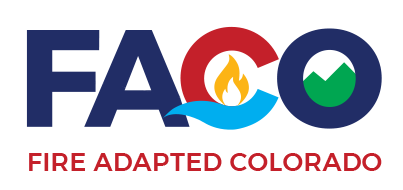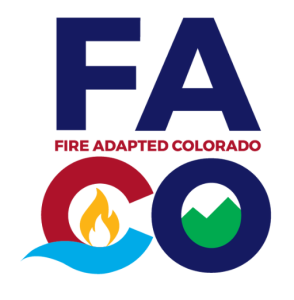Elkhorn Creek Forest Health Initiative-Forest Restoration Through Collaboration
Written by Weston Toll with the Coalition for the Poudre River Watershed
Collaboration (noun): the action of working with someone to produce or create something.
Collaborating on a project is oftentimes the most effective way to achieve goals on a more landscape scale when it comes to hazardous fuels reduction and overall forest health. It is with this idea the Elkhorn Creek Forest Health Initiative (ECFHI) came to be. This partnership between the Coalition for the Poudre River Watershed, the Nature Conservancy, Wildlands Restoration Volunteers, Larimer County Conservation Corps and Ben Delatour Boy Scout Ranch has been able to treat approximately 300 acres of high priority forest on the Ben Delatour scout ranch to reduce wildfire risk and create a more resilient landscape.
The ECFHI was established in 2015 to help maintain and enhance the resiliency of the Cache la Poudre River though management activities aimed to reduce the impact of high severity wildfire on Elkhorn Creek, an important tributary of the Poudre River. This area was identified because of unhealthy forest densities and high fuel loading and because the project complements existing US Forest Service and other treatments in the area. These conditions are the result of fire exclusion over the past 100+ years, so a more open forested condition is being achieved through the use of mechanical and hand thinning and prescribed fire.

Treatment map of Elkhorn Creek Forest Health Initiative
Management Goals
The intent of this work is to create, maintain, or enhance the sustainable multi-resource benefits of a healthy and functional forest ecosystem, with the following key elements:
- Wildfire – create and maintain long-term forest structural conditions that support characteristic low to mixed-severity fire;
- Wildlife – maintain habitat elements at necessary scales to benefit multiple-species and guilds, such as but not limited to ungulates, Abert ‘s squirrel, Merriam’s turkey, and cavity nesting birds;
- Forest Health – create and maintain conditions that support resilience and resistance to insect and disease, by managing for openings and complex forest structure;
- Hydrologic Function – ensure long-term conditions that support water quality and quantity appropriate to the forest type, soils, hydrology of the site;
- Aesthetics and Recreation – maintain a visual pleasing forest structure by promoting complex forest management to achieve non-uniform (e.g. no “straight lines”) outcomes; remove hazards to users of the property for a variety of activities related (but not limited to) to hiking, orienteering, camping, and horseback riding;
- Education and Volunteerism – support educational activities for users and volunteers with science-based frameworks for forest management; facilitate understanding of the management activities contained in this plan and other documents and curriculum;
- Forest Products – provide forest products such as firewood, saw logs, and biomass to offset costs of the treatments and maintain a working forest per the Forest Legacy Program.

Before treatment at Ben Delatour Scout Ranch

After treatment at Ben Delatour Scout Ranch
Prescribed Fire as a Management Tool – Success on Private Land!
Prescribed fire was utilized as an effective tool to reduce hazardous fuel loading and to reintroduce fire onto this landscape. In September around 40 people from various organizations and agencies came together to implement a 150-acre prescribed fire on the scout ranch – the first such burn on private land in the Poudre watershed! We will be continuing to identify additional prescribed fire burn units in this area, as well as supporting the USFS burn program which has similar cross-boundary projects nearby.

Prescribed burn Sept 2017
Results
Recently, the Elkhorn Creek Forest Health Initiative was awarded the 2017 Larimer County Stewardship award for our work on the scout ranch. This is partially due to some of the great results we are seeing through our post treatment monitoring, compiled in a report by Rob Addington of the Nature Conservancy.
Basal area was reduced from an average 95 ft2 per acre before the treatment to 55 ft2 per acre after the treatment. Canopy cover was also significantly reduced as a result of treatment, from a mean of 46.7% before treatment to 20.7% after treatment. The treatment increased crown base height from an average 12.1 feet prior to treatment to 15.4 feet after the treatment. The reduction in tree basal area and canopy cover, as well as the increase in crown base height, represents a desirable outcome of the treatment. Combined, these changes in forest structure because of the treatment will reduce the potential for high-severity wildfire (Table 1).

(Addinton 2017)
Challenges
While the group has been highly successful overall, there have been a couple of challenges that have arisen. Last winter, high winds resulted in blowdown events across the scout ranch. While a part of the natural process in this area, some of these trees needed to be mitigated for prescribed burning operations and overall aesthetics. We are also running into an issue with removing some of the larger diameter tree boles off site in unit 1. Efforts are being made to utilize this wood in other restoration projects as well as for firewood.
Current Projects
Work on Unit 3 started at the scout ranch this past summer. This unit is on a steep, north facing slope and is around 35 acres in size. Treatment on this unit will include cutting and piling to encourage aspen expansion as well as removing ladder fuels (trees that are smaller than 6 inches diameter at breast height).
In addition to work on Unit 3, a 538-acre burn unit has been identified as well as more fuels reduction projects both on the scout ranch as well as other private land downstream.

Wildlands Restoration Volunteers are an important partner in the ECFHI
Weston Toll is the watershed coordinator for the Coalition for the Poudre River Watershed in Fort Collins, CO. For more information on CPRW or to learn how you can become involved please visit poudrewatershed.org or contact him at weston@poudrewatershed.org.

